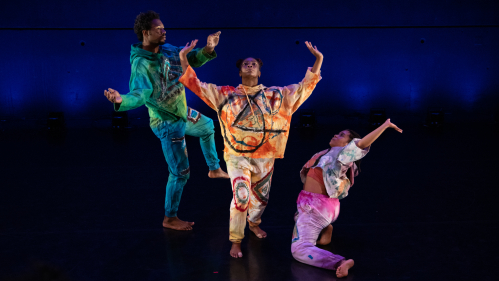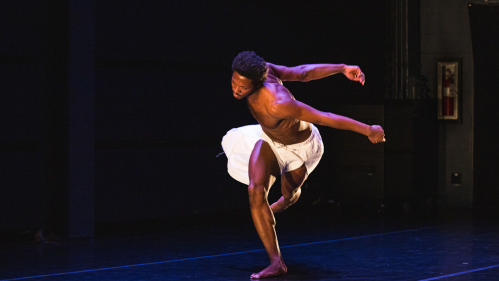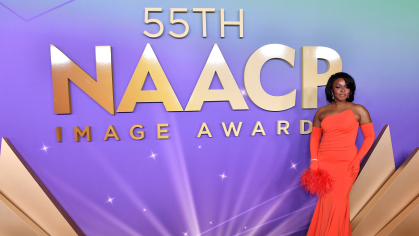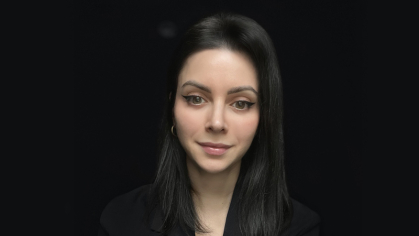Kyle Marshall Emerges From the Pandemic Dancing Toward the Light

Mason Gross alumnus returns to teach and showcase new uplifting works at NBPAC
Since forming an award-winning dance company in 2014, Rutgers alumnus Kyle Marshall has earned accolades for his stirring, socially conscious performances.
While proud of his body of work – including “A.D.” and “Colored,” which tackle themes of spirituality, sexuality and race – the material’s heaviness was taking a toll on him physically and emotionally. Then the pandemic hit, followed by a summer of racial reckoning, and all that darkness inspired Marshall to pivot toward the light.
“I wanted to find other ways of exploring my blackness, my artistry, and my humanity but in a way that wasn’t always dissecting and displaying pain and hurt, because I’m putting myself in that place as a performer. I think we have to be careful about how and who we share that with,” said the 2011 Mason Gross School of the Arts graduate, who spent lockdown exploring new ways to honor his roots and artistic tradition. “This history is one of pain and struggle but also one of joy and celebration and creativity and improvisation – finding ways of making something out of nothing and celebrating our fabulous selves.”
This week he returns to his alma mater to teach and to showcase his new uplifting works with his company, Kyle Marshall Choreography, at the New Brunswick Performing Arts Center. The three performances Oct. 15-16 are Mason Gross’s first since the pandemic. The shows also mark the first performances outside New York City for the company, which includes Mason Gross dance alumni Ariana Speight, Jose Lapaz-Rodriguez and David Parker.
“It definitely feels like a homecoming,” said Marshall, who was raised in North Brunswick and grew up attending dance schools in and around New Brunswick. “As a kid I performed at George Street Playhouse and used to see shows at the State Theatre and Crossroads Theatre Company. It’s really kind of humbling to be back. I think that’s why I put such a big program together.”
That program features four new works, a portion of “I & I,” the world premiere of “Joan,” a live version of “Stellar,” and “Rise.”
“I & I” is a Rastafari term that means “you and I” or “we,” and refers to the divine within that connects us both. The heavily improvisational piece is a departure for Marshall, which he uses to honor “my Jamaican body.”
“My mother’s side of the family is Jamaican, and growing up I had a lot of questions. What does it mean to be a Jamaican and of the diaspora?” he said. “ ‘I & I’ allows me to explore what are the parts of my body that are connected to the island and these traditions. It felt like more than a dance, it felt like a relearning process, and more for my own personal investigation and nurturing and less about the presentation.”
“Joan,” set to music by Julius Eastman, is rooted in Joan of Arc’s narrative and depicts stories of liberation, rebellion, and resistance. Born of Marshall’s experimentation with film and video, “Stellar,” allowed him to “zoom in” on specific parts of the dancing body. The piece also explores themes of jazz improvisation and Afrofuturism elevated by John Coltrane and Sun Ra. And with “Rise,” Marshall took cues from the church and the clubs to celebrate the joys of dancing and gathering.

A decade after his days as a Mason Gross student, the Bessie Award-winner and critically acclaimed artist (The New York Times’ dance writer Siobhan Burke praised him for having “a choreographic voice like no one else’s”) is back at Rutgers this semester as a Repertory Guest Artist with Friday afternoon rehearsals. He is also contributing choreography to the MGSA student dance concert Fall Dance Plus, which is set for Nov. 11-13 at NBPAC.
It’s a full-circle moment that Marshall’s former dance instructor and current artistic sounding board, Kimani Fowlin, said she is delighted to see.
“He is widely respected, so it’s a gift,” said Fowlin, whose work has overlapped with Marshall at Brooklyn Academy of Music and in the Black Dance Stories live video series. “He is coming into a new role for himself. He’s not just performer, not just choreographer, now he is teacher, mentor, and that is a beautiful trajectory. I feel so blessed to see that. He is more than ready for this next rung on the ladder.”
Fowlin recalls there was nothing haphazard or undisciplined about Marshall as a student. “I was like, Kyle, do you ever smile?”
Marshall said he sought out Rutgers specifically for its choreography-heavy program. Throughout his time in New Brunswick, he remained laser focused on one goal: to leave a professional dancer and choreographer.
“The training is strong in a conservatory. You’re getting vigorous, dense, consistent training, which is good because you have to get your body and spirit ready to be out there,” he said of Mason Gross. “All of the companies in New York have at least one Rutgers alumnus. There are Rutgers dancers on TV in ‘Glow,’ working on Broadway, on cruise ships and even Goldman Sachs. That is unique.”
As one of Mason Gross’s faculty of color, Fowlin underscored the importance of Black and brown students being able to see themselves and their lived experiences reflected in their mentors, syllabi and performances.
“For many students of color coming into Rutgers, they have not had someone of color throughout their schooling who speaks of their culture, sees them, uplifts them and supports their own individual journey in dance,” she said. “I think Mason Gross is moving forward in a direction that is more inclusive. It needs work and is willing to do the work, and that’s a start.”


